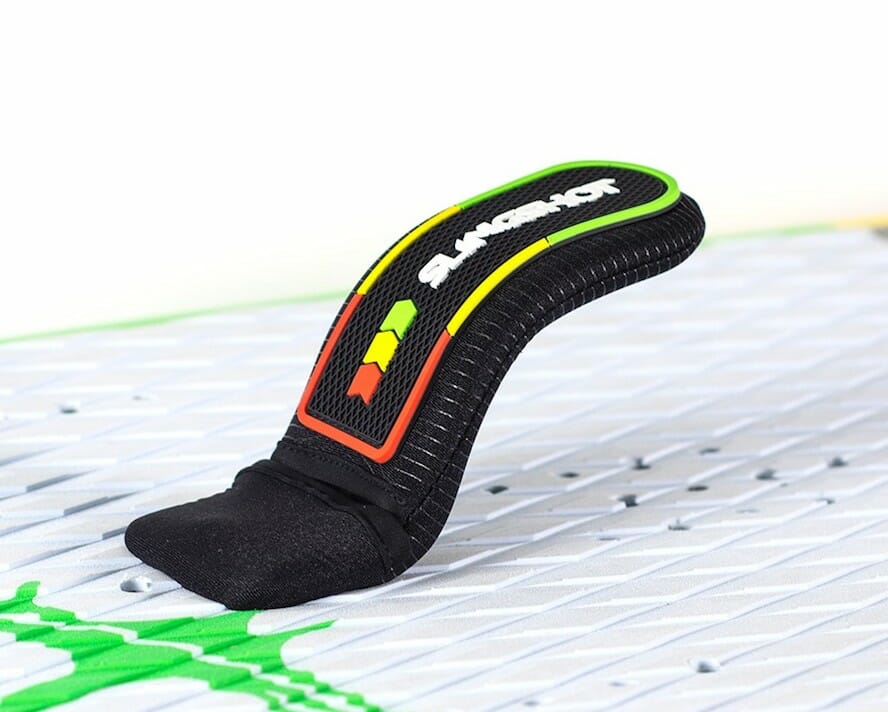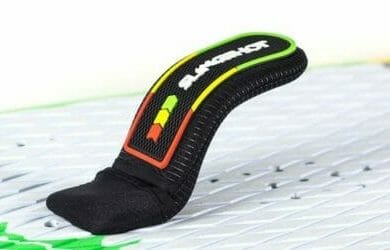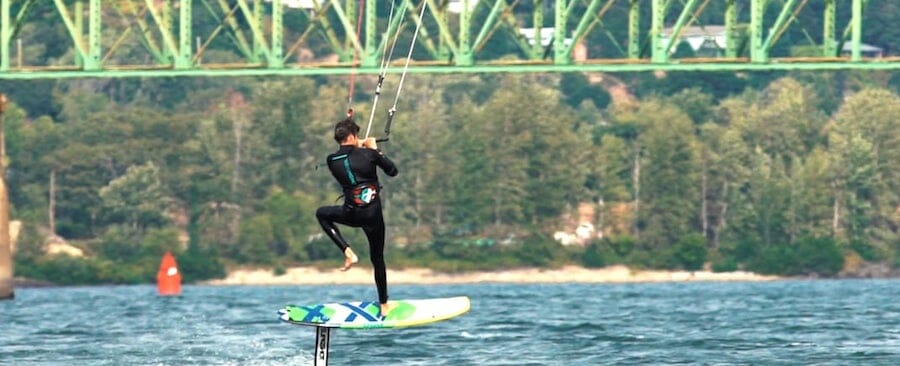
Footstraps for kitefoiling- when you should and should not use them.
Foot straps, half straps or no straps- here’s a breakdown of the key pros and cons of each. It’s an age-old question in foiling: To strap or not to strap. In foiling’s early days, pioneers like Laird Hamilton were fully committed. They strapped themselves to their boards with snowboarding boots and towed into freight-train sized waves that few people had ever surfed. Now we see foilers like Kai Lenny pumping in circles from wave to wave and Fred Hope jumping the height of a three-story building, with nothing but bare feet and a little surf wax on their boards.
Somewhere in between, there’s the rest of us. At Slingshot, it’s a question often asked, usually by entry-level foilers anxious to get started but unsure of what setup is right for them. To strap or not to strap? At the risk of sounding a like a politician, our answer is, “It depends.” It is a matter of personal preference, ability level, and your risk vs. reward calculator. If you’re an experienced kitefoiler, chances are you’ve learned many of these pros and cons already, and most likely you experienced at least a few of them the hard way. If you haven’t, hopefully, this info will help make your decision- and journey kitefoiling- a little smoother.
 Foot straps: pros and cons:
Foot straps: pros and cons:
Pros:
1. Foorstraps secure your feet to the board. Advantage, more power, control, which can mean less crashing and more time riding.
2. Keeps you locked-in during gusty wind, choppy water and when overpowered.
3. Helps when learning to edge hard, carve hard and foil more aggressively.
4. Works as a handle. Helps with getting the board and foil into position when learning and with proper foot placement while you’re riding.
5. Necessary for most levels of jumping and freestyle.
Cons:
1. Feet can get stuck in straps. Increases risk of injury when learning and crashing
2. Straps get in the way during transitions
3. Restricts freedom of movement around board
4. Can slow overall progression if relied on too heavily
5. Use with booties increases risk of getting feet stuck during crash
 Half straps: Pro’s and Cons
Half straps: Pro’s and Cons
Pros:
1. The best of both: provide support and stability while limiting risk of injury
2. Easy to slide your feet in and out of for on-the-fly use
3. Can be better with booties than full foot straps
4. Help’s keep feet locked in during gusty, choppy or overpowered conditions
5. Works as a “stopper” for proper foot placement
6. Works as a handle
Cons:
1. Limits freedom of movement and foot placement on board
2. Less locked-in than full foot straps
3. Can get in the way during transitions
4. Still some risk of getting feet stuck during a crash
5. Rigid, less forgiving than foot straps

No straps:
Pros:
1. Full freedom of movement
2. Less risk of injury when crashing
3. Best for learning transitions, tacking and jibing and riding toeside
4. Much safer in swell/waves
5. Encourages more exceptional foiling skills and kite control
Cons:
1. Harder to get board into position when starting
2. More likelihood of crashing as you learn
3. Easier to get “bucked off” in challenging conditions
4. Can’t jump (unless you’re a pro)
5. Considered harder when learning than with some form of straps
Should you use straps for kiting?
Of all the foiling disciplines, kitefoiling is the most up for interpretation when it comes to learning with foot straps, half straps or no straps. There’s no right or wrong answer- it comes down to personal preference and risk management. Learning can be quicker, easier and more comfortable with foot straps- they help you keep the board in the right position while you’re getting started, they lock you in and help prevent crashing as you get the hang of the kite control, body positioning and weight distribution needed for controlled foiling. On the other hand, getting your feet stuck in the straps and tweaking your knees or ankles in a crash is a real, almost inevitable, possibility. And, once you’re foiling, straps can get in the way during transitions. Half straps provide the happy medium, but even those aren’t perfect- they still take up space on the deck and they don’t lock your feet in as much as traditional straps. Learning strapless eliminates the risk of getting your feet stuck, but increases the risk of crashing in other ways.
Our recommendation:
- Don’t be afraid of learning with straps, just be careful. Keep them as loose as possible and don’t wedge your feet in all the way. Straps can be a big help in learning, and if you keep them loose, you can kick out as you crash. Once you’re past the initial learning curve, straps are great for locking you in as you ride more aggressively, edge harder and start foiling in stronger winds.
- If you have knee or ankle issues you’re worried about, just accept the fact that you’ll probably learn a little slower and start strapless. The last thing you want to do is hurt yourself and be out
for the season. Get a set of half straps and keep them close by. It’s very likely at some point soon you’ll want to try them, either because you’re struggling and need some extra support, or
because you’re succeeding and are ready to step it up. - If you have large feet or ride regularly with booties and would easily get stuck in straps, start with half straps. They’re not as secure as full surf straps, but they’re still a big help, and in your
case not being fully locked in is probably a good thing.
Sign up for Foil-academy.com and gain access to the number 1 rated online class for learning to kitefoil

